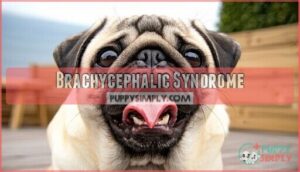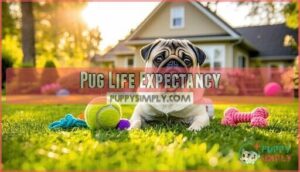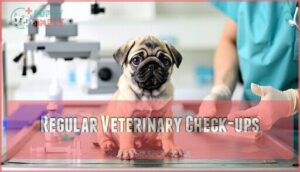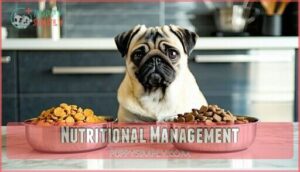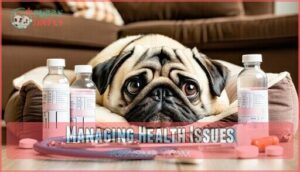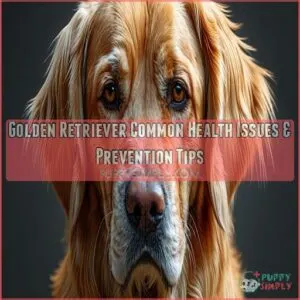This site is supported by our readers. We may earn a commission, at no cost to you, if you purchase through links.

Genetics play a big role, but so do factors like diet, exercise, and regular vet check-ups.
Pugs are known for their adorable squishy faces, but those same features can lead to breathing issues that might affect their longevity.
Keeping their weight in check and providing lots of love and care can make a world of difference.
With the right attention, some pugs even surpass 15 years, and curious owners can learn how to keep their pug thriving well into their senior years by keeping reading.
Table Of Contents
- Key Takeaways
- Pug Lifespan Overview
- Factors Affecting Pug Life
- Pug Age Calculation
- Common Health Challenges
- Pug Life Expectancy
- Extending Pug Lifespan
- Pug Care and Longevity
- Frequently Asked Questions (FAQs)
- Can a Pug live 20 years?
- Is 7 old for a Pug?
- What is Pug weakness?
- How often do pugs need vet check-ups?
- What are the benefits of socializing a pug puppy?
- What kind of diet should pugs be fed?
- What types of activities are safe for a pug?
- What signs should I look out for to determine if my pug is a senior?
- How do seasonal climates affect Pug lifespan?
- Can Pugs adapt to high-altitude environments?
- Conclusion
Key Takeaways
- You can expect your pug to live 12-15 years on average, with females typically outliving males by a few months, though exceptional pugs, like Snookie, have reached 27 years with proper care.
- Your pug’s genetics play the biggest role in lifespan, but you can significantly impact their longevity through a quality diet, regular exercise, spaying/neutering, and choosing reputable breeders who conduct health screenings.
- You’ll need to manage breed-specific health challenges like brachycephalic syndrome, which affects breathing, plus watch for overheating, obesity, and dental problems that commonly shorten pug lifespans.
- Regular vet check-ups and preventative care are essential for early detection of health issues, along with maintaining proper weight, providing mental stimulation, and creating a safe indoor environment to maximize your pug’s lifespan.
Pug Lifespan Overview
You can expect your pug to live between 12 to 15 years on average, which is pretty standard for small dog breeds.
Pugs typically live 12 to 15 years, offering endless love and wrinkly companionship throughout their joyful, tail-wagging journey.
Though some lucky pugs have reached 16 years or more with excellent care.
While genetics play the biggest role in determining your pug’s lifespan, factors like diet, exercise, and regular vet visits can help your wrinkly companion live a longer, healthier life.
Average Lifespan
When considering your pug’s life expectancy, you’ll find these adorable companions typically live 12-15 years.
This average pug lifespan places them right in the middle compared to other breeds—longer than large dogs but shorter than tiny breeds like Chihuahuas.
Here’s what lifespan statistics reveal about pug longevity:
- Most pugs reach their golden years around 13-14 years old
- Some exceptional pugs live beyond 16 years with proper care
- The oldest recorded pug, Snookie, amazingly reached 27 years
The information provided helps in understanding the average lifespan and exceptional cases of pugs, making it easier for owners to plan and care for their pets.
Factors Influencing Longevity
Several key factors shape your pug’s lifespan beyond basic genetics.
Genetic predisposition plays the biggest role, but your daily choices matter too.
A quality pug diet, regular pug exercise, and neutering effects all boost longevity.
An indoor lifestyle protects against accidents and weather extremes.
Understanding these pug health issues helps you make informed decisions that directly impact your pug’s lifespan.
Oldest Recorded Pug
Snookie, a South African Pug, shattered all expectations by living to 27 years old—that’s Snookies Secrets to exceptional longevity in action.
Snookie, the remarkable South African Pug, defied the odds, living 27 incredible years and setting the ultimate longevity record.
This record verification showcases what’s possible beyond typical Pug lifespan ranges.
Whether it’s a genetic anomaly or environmental impact, Snookie proves the oldest Pug on record can inspire hope for your furry friend’s Pug longevity journey.
Factors Affecting Pug Life
Your pug’s lifespan depends on several key factors that you can actually control, from the food you choose to the exercise routine you establish.
Understanding these influences helps you make informed decisions that can add precious years to your furry friend’s life, turning those wrinkled faces into even more memorable moments together, with informed decisions being crucial.
Genetics and Health
Your pug’s genetics play a huge role in determining their lifespan.
Responsible breeding practices help minimize inherited disorders like PDE disease, which can be fatal.
Genetic predisposition affects pug health problems substantially.
Choose breeders who conduct health screenings and provide detailed family histories.
Good pug genetics from healthy bloodlines contribute to better pug longevity, while poor breeding practices increase pug health issues, highlighting the importance of responsible breeding.
Diet and Nutrition
Quality kibble selection forms the foundation of your pug’s health journey.
Choose age-appropriate formulas that support weight management, as pugs love food but struggle with obesity.
Hydration importance can’t be overstated—fresh water prevents kidney issues.
Consider supplement options like omega-3 for skin health.
Maintaining a healthy weight is vital, so explore options for pug weight solutions.
Understanding your pug’s dietary needs guarantees proper pet nutrition that extends their lifespan substantially.
Exercise and Activity
Regular exercise keeps your pug healthy, but their flat faces mean you’ll need a smart approach.
Short bursts work better than marathon sessions since breathing issues can quickly become dangerous.
Here’s your pug exercise routine:
- 15-minute walks three times daily for joint health
- Indoor play sessions during hot weather to prevent overheating
- Puzzle toys for mental stimulation when physical activity isn’t possible
Spaying and Neutering
Beyond keeping your pug active, spaying and neutering offers significant health benefits that directly impact pug lifespan.
These procedures provide reduced cancer risk by eliminating reproductive organ cancers.
You’ll notice behavioral changes like decreased aggression and roaming tendencies.
While surgical considerations and recovery process require careful planning, the population control benefits and overall Pug health improvements make spaying and neutering valuable Pug lifespan factors worth discussing with your veterinarian.
Pug Age Calculation
You might wonder how your pug’s age compares to human years, and the answer isn’t as simple as multiplying by seven.
Understanding your pug’s real age helps you provide better care as they move through different life stages, from energetic puppyhood to their golden senior years.
Human Equivalent Age
Understanding your Pug’s age in human years helps you provide appropriate care at each life stage.
A 12-year-old Pug equals a 59-year-old human, while your 7-year-old companion matches a 44-year-old person.
This Pug dog age chart reveals how rapidly they mature—your 2-year-old Pug has already reached the equivalent of 23 human years, making early health decisions critical.
Life Stages and Development
Your pug’s journey unfolds through distinct life stages, each bringing unique joys and challenges.
Puppy Development spans birth to six months, featuring rapid growth and learning.
Adult Fitness peaks from six months to seven years, when your pug enjoys prime health.
Senior Care becomes essential after seven years, as aging signs emerge and life expectancy considerations guide your caregiving approach.
Aging Indicators
As your pug ages, you’ll notice telltale dog aging signs that signal they’re entering their golden years.
A graying muzzle appears first, usually around seven years old.
Dental changes become obvious, while reduced activity and vision changes follow.
Watch for cognitive decline too—senior pug care requires attention to these pug aging signs for proper senior dog care during the dog aging process.
Common Health Challenges
Your pug’s flat face and compact build make them adorable, but these same features can create serious health problems throughout their life.
You’ll need to watch for breathing difficulties, overheating issues, and conditions like Pug Dog Encephalitis that can affect both puppies and adult dogs.
Puppies and Adult Pugs
Health challenges often vary dramatically between different life stages in your Pug’s journey.
Understanding these differences helps you provide better care throughout their lifespan.
Key health considerations for each life stage include:
- Pug puppy health requires vigilant vaccination schedules and parvovirus prevention
- Adult Pug health focuses on weight management and joint care
- Training needs shift from basic commands to behavioral maintenance
- Behavioral changes emerge as your companion matures and ages
Brachycephalic Syndrome
Flat faces come with a price.
Brachycephalic syndrome affects your pug’s breathing, causing noisy panting and overheating risks.
This genetic condition creates dental problems and restricts airflow through narrow nostrils.
While surgical options exist for severe cases, management strategies like avoiding hot weather and strenuous exercise help brachycephalic dogs breathe easier and live healthier lives.
Pug Life Expectancy
You can expect your pug to live between 12 to 15 years on average, though some lucky pugs reach 16 years or more with proper care.
Your pug’s actual lifespan depends on several key factors, including genetics, diet, exercise, and how well you manage their health throughout their life.
Average Lifespan Range
Most pugs live between 12 to 15 years, putting their pug lifespan right in the sweet spot for toy breeds.
Your female pug might outlive males by a few months, with pug life expectancy averaging 13.2 years versus 12.8 years.
While breed comparison shows pugs exceed the general dog population’s 10-13 pug years, longevity extremes like 18-year-old King Tug prove exceptional pug longevity happens.
Influencing Factors
Several key elements shape your pug’s lifespan beyond those basic numbers.
Genetic predisposition plays the biggest role—healthy bloodlines mean fewer inherited problems.
Diet quality directly impacts longevity, while meeting their unique exercise needs keeps them fit without overexertion.
Neutering impact reduces cancer risks, and maintaining proper indoor environment protects against accidents and temperature extremes, ensuring a longer lifespan with fewer inherited problems.
Maximizing Lifespan
With proper care and attention, you can substantially extend your pug’s lifespan beyond the average 12-15 years.
Smart choices make all the difference in pug longevity.
Here are four essential strategies for pug lifespan extension:
- Genetic Screening – Choose reputable breeders who test for hereditary conditions
- Preventative Care – Schedule regular vet visits for early detection of health issues
- Weight Management – Maintain ideal body weight through proper diet and exercise
- Mental Wellbeing – Provide enrichment activities and social interaction for overall dog longevity
Extending Pug Lifespan
You can substantially extend your pug’s life by focusing on regular vet visits, proper nutrition, daily exercise, and managing breed-specific health issues like breathing problems.
These simple steps, when combined with consistent grooming and weight management, can help your wrinkly companion enjoy many more years of tail-wagging happiness with your family.
Regular Veterinary Check-ups
Routine veterinary care forms the backbone of extending your Pug’s lifespan.
Annual checkups allow early detection of Pug health issues before they become serious problems.
Your vet will maintain vaccination schedules, monitor dental hygiene, and provide parasite control.
Preventative care catches breathing problems, joint issues, and other concerns that commonly affect Pugs, giving your furry friend the best shot at a long, healthy life, with proper vaccination schedules and parasite control.
Nutritional Management
Beyond regular checkups, your Pug’s nutrition forms the backbone of their health.
An ideal diet matched to their age prevents obesity-related complications that shorten lifespans.
Your Pug nutrition strategy should include:
- High-quality kibble matched to your dog’s life stage and activity level
- Consistent hydration needs with fresh water available throughout the day
- Strict weight management through portion control and healthy treats.
Senior dog nutrition requires special attention.
Adequate Exercise and Grooming
Your pug’s exercise frequency should match their breathing limits—short, frequent walks work better than marathon sessions.
Activity levels decrease with age, so adjust routines accordingly.
Regular grooming needs include cleaning facial wrinkles to prevent infections and brushing to manage shedding.
Proper care requires specialized pug products to keep them healthy.
Weight management through controlled portions and daily movement prevents pug obesity, especially important for senior dogs requiring gentler exercise routines.
Managing Health Issues
Early symptom detection can catch common pug diseases before they become serious threats to your pug’s lifespan.
You’ll need consistent medication adherence and clear veterinary communication to manage conditions like brachycephalic syndrome effectively.
Don’t overlook alternative therapies when traditional treatments fall short. Sometimes palliative care becomes necessary, but proper pug health tips and proactive aging management help prevent many pug causes of death entirely.
Pug Care and Longevity
You can substantially impact your pug’s lifespan through careful attention to genetics, environment, and daily care choices.
Your commitment to regular vet visits, proper nutrition, and understanding your pug’s unique needs will help guarantee they live their healthiest, longest life possible.
Breeding History and Genetics
Understanding your pug’s breeding history reveals essential insights about genetic predispositions and purebred lifespan expectations.
Responsible breeding practices substantially impact genetic diversity, while health screenings help identify potential issues early.
Pug genetics carry both strengths and vulnerabilities passed down through generations. When choosing a pug, you’ll want breeders who prioritize pug breed information and conduct thorough health testing for ideal breed lifespan outcomes.
Lifestyle Factors and Environment
While genetics lay the foundation, your pug’s environment shapes their quality of life daily.
Creating the right living conditions directly impacts your pug’s lifespan and overall wellbeing.
Your pug’s lifestyle factors and environment play a major role in determining how long they’ll be by your side:
- Indoor safety protects your pug from accidents, toxic plants, and extreme weather that could shorten their life
- Climate control keeps your temperature-sensitive pug comfortable, preventing dangerous overheating or cold stress
- Socialization impacts their mental health – lonely pugs often develop anxiety and depression that affects longevity
- Mental enrichment through puzzle toys and training keeps their mind sharp and prevents destructive behaviors
- Stress reduction in a calm, predictable home environment helps your pug live longer, healthier years
Pug living conditions matter more than you might think.
These wrinkly companions thrive in stable, controlled environments where they feel secure and loved.
Proper Care and Attention
Daily attention to your pug’s needs dramatically impacts their lifespan and quality of life.
Mental stimulation through puzzle toys prevents boredom, while socialization needs require regular interaction with people and pets.
Proper grooming practices, including weekly brushing and nail trims, maintain health.
Don’t overlook dental hygiene—brushing teeth prevents serious infections, and your pug’s emotional wellbeing thrives with consistent, loving care.
Health Insurance and Vet Visits
Why wait until disaster strikes? Pet insurance for Pugs covers 70-90% of unexpected vet bills, with emergency coverage often exceeding $1,000 for breathing issues.
Preventative care add-ons help manage routine costs, while policy options include direct-vet-pay for convenience. Consider researching pug health insurance for your pet.
Finding vets becomes stress-free since all US clinics accept insurance. Pet insurance benefits protect your wallet and your pug’s health. Pet insurance is a crucial investment for any pug owner, providing emergency coverage and preventative care.
Frequently Asked Questions (FAQs)
Can a Pug live 20 years?
Yes, though rare, a Pug can live 20 years with exceptional care. Focus on a healthy diet, regular vet visits, and avoiding obesity. The oldest Pug reached 27, proving it’s possible!
Is 7 old for a Pug?
Seven isn’t too old for a Pug, but it’s when they’re considered seniors.
Expect some slower movements and graying fur.
With proper care, like exercise and a good diet, they’ve still got great years ahead!
What is Pug weakness?
Like a tiny superhero with a kryptonite, Pugs struggle with breathing issues due to their flat faces.
They’re prone to obesity, heat sensitivity, dental woes, and joint problems, needing careful care to thrive happily.
How often do pugs need vet check-ups?
You should take your pug to the vet at least twice a year.
Regular check-ups catch problems early, and your pug’s unique health quirks, like breathing or weight issues, need expert attention to stay happy and healthy.
What are the benefits of socializing a pug puppy?
A stitch in time saves nine—socializing your pug puppy early helps them grow into confident, friendly adults.
It reduces fear, improves behavior, and strengthens bonds with people and pets, making life smoother for everyone, as socializing is key in this process.
What kind of diet should pugs be fed?
Feed your Pug high-quality kibble balanced for their age and activity, adding lean proteins, veggies, and fruits.
Avoid fatty foods and overfeeding—Pugs love snacks but can quickly pack on unhealthy pounds!
What types of activities are safe for a pug?
Think of Pugs as cozy couch potatoes with bursts of energy.
Short walks, gentle fetch, or puzzle toys are best.
Avoid long hikes or intense play—they’ve got small lungs and big personalities to protect!
What signs should I look out for to determine if my pug is a senior?
Your pug might be a senior if they’re slowing down, graying around the muzzle, sleeping more, or struggling with steps.
Watch for changes in appetite, decreased energy, or stiffness—it’s like they’ve discovered the joys of retirement!
How do seasonal climates affect Pug lifespan?
Seasons weave life’s tapestry differently for your Pug.
Hot summers can strain breathing in their flat noses, while chilly winters might challenge their joints.
Keep them cozy, hydrated, and indoors during extremes to promote longevity.
Can Pugs adapt to high-altitude environments?
High altitudes can challenge Pugs due to their flat noses, making breathing tougher.
They may adapt with time, but you’ll need to monitor for breathing issues, avoid strenuous activity, and make certain they’re comfortable.
Conclusion
Who knew such a small dog could hold such big secrets to longevity? A pug’s lifespan depends on your dedication to their health—balanced nutrition, regular exercise, and consistent vet visits are key.
Watch for signs of aging, and don’t let those cute, squishy faces fool you—breathing issues need attention.
With care and love, your pug can thrive well into their golden years, giving you many more snuggles, snorts, and heartwarming moments to cherish.
- https://a-z-animals.com/blog/the-top-8-oldest-dogs-ever/
- https://www.pedigree.com/dog-care/dog-age-calculator
- https://www.petmd.com/dog/conditions/infectious-parasitic/c_dg_canine_parvovirus_infection
- https://www.akc.org/expert-advice/nutrition/breed-weight-chart/
- https://pmc.ncbi.nlm.nih.gov/articles/PMC10362839/




